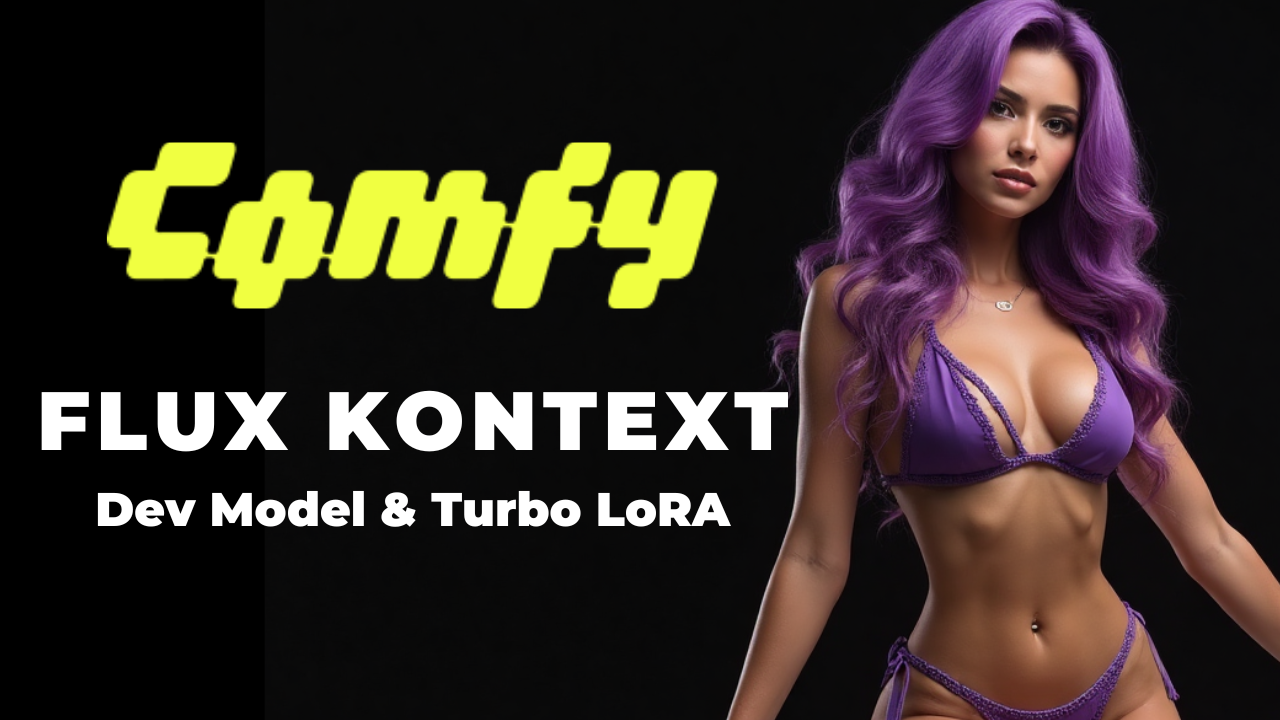FAST Flux1 Kontext Dev Generations with Turbo LoRA (ComfyUI)

Table of Contents
1. Introduction
Welcome to the FAST Generations tutorial with Flux1 Kontext Dev and Turbo LoRA in ComfyUI! Learn how to speed up image generation to just 4-8 steps, cutting render time in half—perfect for artists and developers boosting workflow efficiency.
If you are new to ComfyUI, we recommend checking out our comprehensive guide below. This will provide you with the foundational knowledge needed to follow along with this tutorial.:
In this tutorial, we will cover the following key areas: the requirements for running the Flux1 Kontext model, how to set up your workflow in ComfyUI, and practical examples of image generation using Flux1 Kontext Dev Model along with the Turbo LoRA. By the end of this guide, you will be equipped with the skills to utilize the Flux1 Kontext model effectively, enhancing your image editing capabilities. Let’s get started!
2. Requirements for Running the Flux1 Kontext Model
Before using Flux1 Kontext Dev with Turbo LoRA in ComfyUI, make sure to complete these essential setup steps below:
Step 1: Download Base Files (VAE and text encoder files)
Download the following base files from Hugging Face and place them in the correct file directory for ComfyUI:
| File Name | Huggingface Page | File Directory |
|---|---|---|
| t5xxl_fp16.safetensors | Huggingface Page | ..\ComfyUI\models\clip |
| clip_l.safetensors | Huggingface Page | ..\ComfyUI\models\clip |
| ae.safetensors | Huggingface Page | ...\ComfyUI\models\vae |
Step 2: Download the Flux Turbo LoRA
Download the Turbo Flux LoRA file from Hugging Face and place it in the correct file directory for ComfyUI:
| File Name | Huggingface Page | File Directory |
|---|---|---|
| FLUX.1-Turbo-Alpha.safetensors | Huggingface Page | ..\ComfyUI\models\loras |
Step 3: Choose Your Model Version
You can run the Flux1 Kontext Dev model with the Turbo LoRA using either of two options. Download one of the model files listed below and save it in the following folder within your ComfyUI directory: ..\ComfyUI\models\diffusion_models
-
FP8 model – ideal for systems with higher VRAM and better performance.
-
GGUF model – Optimized for systems with 12GB VRAM or less. Choose the version that best matches your available VRAM.
Before we move on to downloading the workflow itself, we need to make sure our ComfyUI setup is up to date. Let’s do that together next!
3. Updating ComfyUI and Downloading the Correct Flux1 Kontext Dev and Turbo LoRA Workflow
Now that you have the necessary files downloaded, it’s time to set up the Flux1 Kontext workflow in ComfyUI. This step is vital to ensure that all components are correctly configured and ready for use. Follow these steps to get started:
Step 1: Update ComfyUI (Windows Portable Users)
Navigate to this folder in your ComfyUI directory:
ts1 2📁 ComfyUI_windows_portable\ 3 └── 📁 update\ 4 └── 📄 update_comfyui.bat
- Run the batch file by double-clicking it.
update_comfyui.bat
Step 2: Download and Import Correct Workflow
Depending on your chosen model version (FP8 or GGUF), download the corresponding workflow JSON file:
-
Flux Kontext FP8 Dev Model + Turbo LoRA Workflow: For higher VRAM systems.
-
Flux Kontext GGUF Dev Model + Turbo LoRA Workflow: For lower VRAM systems (≤12GB).
Once one of the workflow is downloaded, open ComfyUI and drag the JSON file onto the canvas to import and activate the workflow. For this example, we’ll use the GGUF model (flux1-kontext-dev-Q3_K_S.gguf) along with its matching GGUF workflow, designed to run on 12GB or less VRAM—making it accessible to more users.
4. Loading Workflow and Installing Missing Nodes in ComfyUI
Even after updating ComfyUI using the bat file in an earlier step, you might still see red nodes when loading the Flux Kontext GGUF Dev Model and Turbo LoRA workflow.

This means some custom nodes are missing. To resolve this, you’ll need to install the Power LoRA Loader (rgthree) node. Follow these steps:
-
Click the Manager button in the top right corner.
-
Select Install missing custom nodes — ComfyUI will scan for any missing nodes.
-
In the list, locate rgthree-comfy and ControlAltAI_Nodes missing nodes, then click on Install one at a time.

-
Click Restart in the bottom left, confirm the restart, and wait for the reconnection.
-
Once reconnected, refresh your browser tab.
That’s it! We’re now ready to review the settings and use the Flux1 Kontext Dev model together with Turbo LoRA to speed up our generations.
5. Flux Kontext Dev Turbo LoRA: Image-to-Image Generation Configuration
With the workflow set up, it’s time to configure the image-to-image generation settings. This step is crucial for ensuring that your images are generated according to your specifications. Here’s how to do it:

Step 1: Load the Initial Image
Begin by loading the image you wish to edit into the Load Image node. This is the starting point for your transformation.
Step 2: Select the Model
In the Unet Loader (GGUF) node, select your GGUF model file, which in this case is flux1-kontext-dev-Q3_K_S.gguf.
Step 3: Configure Text Encoders
For the DualClipLoader node, select the text encoder models you downloaded earlier. Ensure that you set the type to Flux:
-
clip_name: t5xll_fp16.safetensors
-
clip_name2: clip_1.safetensors
-
Type: Flux
Step 4: Load VAE
Select the ae.safetensors file within the Load VAE node to ensure the model has the necessary components for image generation.
Step 5: Provide Your Prompt
Type a detailed prompt describing how you’d like to edit your image. For example, to change the bikini color in the example uploaded image, you could write: “Change her bikini to purple without altering the background.”
Step 6: Upload and Select Flux Turbo LoRA
Now, in the Power LoRA Loader node, select the Turbo LoRA file (FLUX.1-Turbo-Alpha.safetensors) you downloaded earlier and leave the strength to its default value of 1.
Step 7: Adjust Workflow Settings
Navigate to the Settings tab within the workflow and configure the following nodes:
-
FluxGuidance: Set to 2.5 (controls the influence of your prompt).
-
RandomNoise:
- control after generate: randomize
-
KSamplerSelect:
- sampler_name: euler.
-
BasicScheduler:
- Scheduler: beta
- Steps: 8
- Denoise: 1 (set to start from full noise)
Step 8: Generate
Once all settings are configured, click RUN to initiate the image editing process. This streamlined approach allows you to edit the original images quickly and efficiently.
⚠️ If you prefer not to keep the original aspect ratio (width & height) from your input image, disconnect the width and height links between the Original Ratio Image node and the EmptySD3LatentImage node. Then, enter your custom width and height values directly into the EmptySD3LatentImage node.
6. Conclusion
In conclusion, the Flux1 Kontext Dev Model and Turbo LoRA in ComfyUI tutorial has equipped you with the knowledge and skills to enhance your image editing capabilities significantly. By following the steps outlined in this guide, you can set up your environment, configure workflows, and generate stunning images with remarkable speed.
As you continue to explore the capabilities of ComfyUI and the Flux1 Kontext model, we encourage you to experiment with different prompts and settings to discover what works best for your projects. The world of image editing is at your fingertips, and with the right tools, you can bring your ideas to life faster than ever before. Happy image editing!



